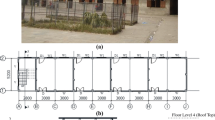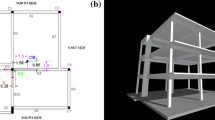Abstract
This work presents the results of a large-scale experimental study aiming to investigate the seismic performance of a three-storey reinforced concrete school building supported on a novel, low-cost, easy-to-implement seismic base-isolation system entitled PVC ‘sand-wich’ (PVC-s). With a modest additional cost and training of builders, the PVC-s system uses locally resourced materials to achieve the intentional initiation of base sliding and the dissipation of seismic energy during earthquakes through the encapsulation of sand grains between two sheets of polyvinyl chloride (PVC) covering the area underneath the raft foundation. Given the prerequisite that the building is adequately designed as a standard earthquake resistant structure, the PVC-s system significantly enhances its seismic performance under moderate to extreme seismic events by acting as a ‘fuse’ that reduces the transfer of energy to the superstructure, while also achieving long term financial benefits by limiting the degree of seismic damage experienced during the life cycle of the structure. The effectiveness of the PVC-s system is shown experimentally and numerically through a probabilistic framework of incremental dynamic analyses (IDA) on a detailed three-dimensional finite-element model of the school building triaxially excited with a suite of 30 ground motions. Seismic demand reduction was estimated in the range of 30% to 70% for the design-level ground motion intensity and above. The analyses also contributed to optimising the length of the gap between the sliding system and the non-structural perimeter parapet wall that was not explored experimentally. The detailed experimental and numerical investigation demonstrate that the PVC-s system is a feasible, low-cost alternative for seismic isolation that can be appealing in low-income countries and beyond.
Access this chapter
Tax calculation will be finalised at checkout
Purchases are for personal use only
Similar content being viewed by others
References
Warn, G.P., Ryan, K.L.: A review of seismic isolation for buildings: historical development and research needs. Buildings 2, 300–325 (2012)
Kumar, M., Whittaker, A.S., Constantinou, M.C.: Characterizing friction in sliding isolation bearings. Earthquake Eng. Struct. Dynam. 44, 1409–1425 (2015)
Furinghetti, M., Pavese, A., Quaglini, V., Dubini, P.: Experimental investigation of the cyclic response of double curved surface sliders subjected to radial and bidirectional sliding motions. Soil Dyn. Earthq. Eng. 117, 190–202 (2019)
Kelly, J.M.: Seismic isolation systems for developing countries. Earthq. Spectra 18, 385–406 (2002)
Tsiavos, A., Sextos, A., Stavridis, A., Dietz, M., Dihoru, L., Alexander, N.A.: Large-scale experimental investigation of a low-cost PVC ‘sand-wich’ (PVC-s) seismic isolation for developing countries. Earthq. Spectra 36, 1886–1911 (2020)
Tsiavos, A., et al.: Low-cost hybrid design of masonry structures for developing countries: shaking table tests. Soil Dyn. Earthq. Eng. 146, 106675 (2021)
Tsiavos, A., et al.: A sand-rubber deformable granular layer as a low-cost seismic isolation strategy in developing countries: experimental investigation. Soil Dyn. Earthq. Eng. 125, 105731 (2019)
Tsiavos, A., Sextos, A., Stavridis, A., Dietz, M., Dihoru, L., Alexander, N.A.: Experimental investigation of a highly efficient, low-cost PVC-Rollers Sandwich (PVC-RS) seismic isolation. Structures. 33, 1590–1602 (2021)
Calvi, P.M., Calvi, G.M.: Historical development of friction-based seismic isolation systems. Soil Dyn. Earthq. Eng. 106, 14–30 (2018)
CEN (European Committee for Standardisation): Eurocode 8: Design of structures for earthquake resistance - Part 1: General rules, seismic actions and rules for buildings. EN 1998-1:2004 (E), Brussels, EN 1998-1:2004 (E) (2004)
Avramidis, I., Athanatopoulou, A., Morfidis, K., Sextos, A., Giaralis, A.: Eurocode-Compliant Seismic Analysis and Design of R/C Buildings: Concepts. Springer International Publishing, Commentary and Worked Examples with Flowcharts (2016)
Vassiliou, M.F., Tsiavos, A., Stojadinović, B.: Dynamics of inelastic base-isolated structures subjected to analytical pulse ground motions. Earthquake Eng. Struct. Dyn., 1–18 (2013)
Kikuchi, M., Black, C.J., Aiken, I.D.: On the response of yielding seismically isolated structures. Earthquake Eng. Struct. Dynam. 37, 659–679 (2008)
Masroor, A., Mosqueda, G.: Experimental simulation of base-isolated buildings pounding against moat wall and effects on superstructure response. Earthquake Eng. Struct. Dynam. 41, 2093–2109 (2012)
Vamvatsikos, D., Cornell, C.A.: Incremental dynamic analysis. Earthquake Eng. Struct. Dynam. 31, 491–514 (2002)
Giordano, N., et al.: Financial assessment of incremental seismic retrofitting of Nepali stone-masonry buildings. Int. J. Disaster Risk Reduction. 60, 102297 (2021)
National Reconstruction Authority: Seismic Design of Buildings in Nepal. NBC 105: 2020. Babar Mahal, Kathmandu, Nepal (2020)
ADRA (Adventist Development and Relief Agency): Disaster Resilience Education and Safe School (DRESS). http://adranepal.org/?p=1102. Assessed 28 Apr 2022
Seismosoft Ltd.: SeismoStruct User Manual, Pavia, Italy (2022)
Mazzoni, S., Frank, M., Scott, M.H., Fenves, G.L.: OpenSees Command Language Manual., Pacific Earthquake Engineering Research Center, University of California, Berkeley, California, USA (2006)
Kibble, T.W.B., Berkshire, F.H.: Classical Mechanics. Imperial College Press, London, UK (2004)
Wen, Y.-K.: Method for random vibration of hysteretic systems. J .Eng. Mech. Div. 102, 249–263 (1976)
MathWorks Inc.: Matlab R2021a (2021). https://uk.mathworks.com/products/matlab.html
Walck, C.: Hand-book on Statistical Distributions for Experimentalists. University of Stockholm, Stockholm, Sweden (2007)
ATC (Applied Technology Council): Seismic Evaluation and Retrofit of Concrete Buildings., USA (1996)
Uma, S.R., Ryu, H., Luco, N., Liel, A.B., Raghunandan, M.: Comparison of main-shock and aftershock fragility curves developed for New Zealand and US buildings. In: 9th Pacific Conference on Earthquake Engineering, pp. 1–9, Auckland, New Zealand (2011)
Ghobarah, A.: On drift limits associated with different damage levels. In: International Workshop on Performance-Based Seismic Design Concepts and Implementation, pp. 321–332. Pacific Earthquake Engineering Research Center, Bled, Slovenia (2004)
Haselton, C.B., Liel, A.B., Deierlein, G.G., Dean, B.S., Chou, J.H.: Seismic Collapse Safety of Reinforced Concrete Buildings. I: Assessment of Ductile Moment Frames. J. Struct. Eng. 137, 481–491 (2011)
Ancheta, T., et al.: PEER NGA-West2 Database, Technical Report PEER 2013/03. California, USA (2013)
Acknowledgements
The authors would like to thank their colleagues at the National Society for Earthquake Engineering in Nepal, namely, Dr. Surya Narayan Shrestha, Dr. Narayan Prasad Marasini, Dr. Hima Shrestha, Mr. Vibek Manandhar, as well as their colleagues from Arup, Mrs. Vita Sanderson, Hayley Gryc, Timurham Timur and Jorge Lopez.
Author information
Authors and Affiliations
Corresponding author
Editor information
Editors and Affiliations
Rights and permissions
Copyright information
© 2022 The Author(s), under exclusive license to Springer Nature Switzerland AG
About this paper
Cite this paper
Sextos, A.G., Zhang, Z., Alexander, N.A. (2022). Large-Scale Testing for Enhancing the Resilience of Schools in Seismic Regions: Challenges and Cost-Efficient Solutions. In: Vacareanu, R., Ionescu, C. (eds) Progresses in European Earthquake Engineering and Seismology. ECEES 2022. Springer Proceedings in Earth and Environmental Sciences. Springer, Cham. https://doi.org/10.1007/978-3-031-15104-0_26
Download citation
DOI: https://doi.org/10.1007/978-3-031-15104-0_26
Published:
Publisher Name: Springer, Cham
Print ISBN: 978-3-031-15103-3
Online ISBN: 978-3-031-15104-0
eBook Packages: Earth and Environmental ScienceEarth and Environmental Science (R0)




